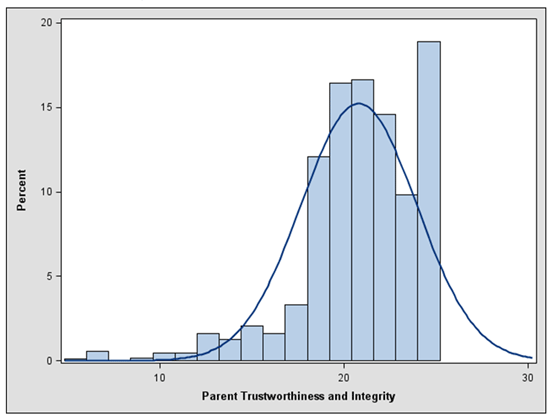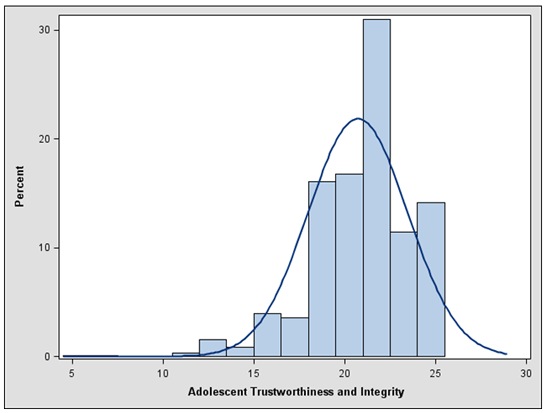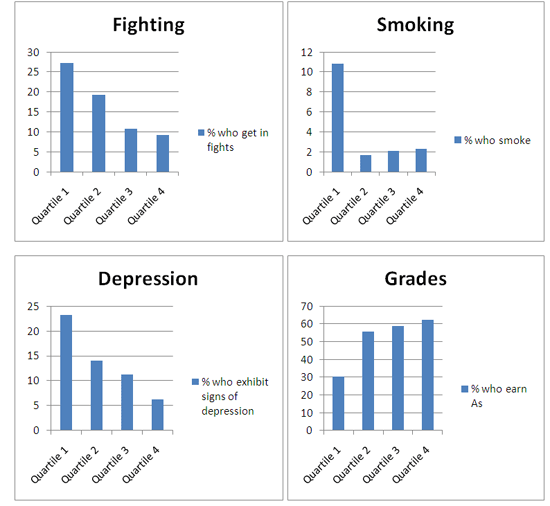Trustworthiness and Integrity
Definition
One can be counted on to be truthful and to consistently keep commitments over time. One can be counted on to act with integrity: i.e., keeping to your principles even when it’s difficult to do so, engaging in ethical behavior, and respecting others’ privacy and property.
-
(Can be counted on to) be truthful
-
(Can be counted on to) keep commitments
-
(Can be counted on to) act with integrity
Parent Scale
Please indicate how often this happens. How often… (None of the time, A little of the time, Some of the time, Most of the time, All of the time)
-
Can others trust your child?
-
Does your child keep the promises he/she makes?
-
Does your child stick to his/her values even when it’s hard?
-
Can your child be counted on to tell the truth?
-
Does your child have a strong sense of right and wrong?
Parent Scale Psychometric Properties and Fit Indices
We conducted confirmatory factor analysis (CFA) to examine whether responses to the scale appeared to measure a single construct. Along with Cronbach’s alpha, we present model fit indices below.

-
Alpha=0.89 (excellent)
-
CFI=0.998 (excellent)
-
TLI=0.994 (excellent)
-
RMSEA=0.072 (adequate)
Adolescent Scale
Please indicate how often this happens. How often… (None of the time, A little of the time, Some of the time, Most of the time, All of the time).
-
Can others trust you?
-
Do you keep the promises you make?
-
Do you stick to your values even when it’s hard?
-
Can you be counted on to tell the truth?
-
Do you have a strong sense of right and wrong?
Adolescent Scale Psychometric Properties and Fit Indices

-
Alpha=0.79 (good)
-
CFI=1.000 (excellent)
-
TLI=1.001 (excellent)
-
RMSEA=0.000 (excellent)
Subgroup Model Fit
We tested the final adolescent and parent models with subgroups to examine whether the model fit for different subsets of respondents in the same manner as the overall sample. Using the same fit statistic requirements as the overall models, a check mark indicates that the model fit for the subgroup. Household income is defined as “low” if it is less than the median income in the sample. “High” household income indicates that the household income was equal to or greater than the sample’s median.

Concurrent Validity
Four single item measures were used to examine the concurrent validity of the adolescent scale: a measure of social behavior (fighting), a measure of health behavior (smoking), a measure of emotional health (adolescent-reported depressive symptoms), and a measure of cognitive development (grades).
Concurrent validity was examined in two ways: with bivariate and multivariate analyses. The table below presents the results of multivariate analyses, which control for: teen gender, teen age, teen race, household income, household size, parental education, parental marital status, parental home ownership, parental employment, and metropolitan area and region of residence. The beta coefficient of the relationship between the construct’s scale and outcome is presented.

The graphs below show the bivariate relationships between the adolescent scale and outcomes. Results are presented for relationships that were at least moderately significant (at the 0.10 level) in the multivariate analyses. Note that the y axis scales are different in each graph.

© Copyright 2024 ChildTrendsPrivacy Statement
Newsletter SignupLinkedInThreadsYouTube